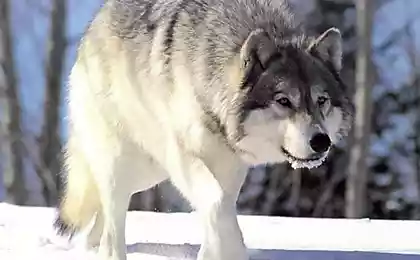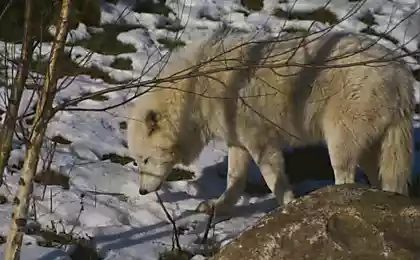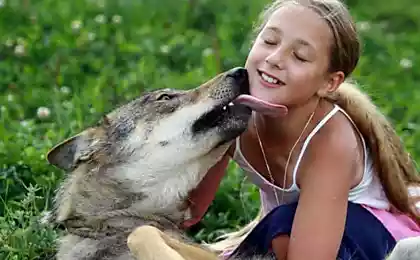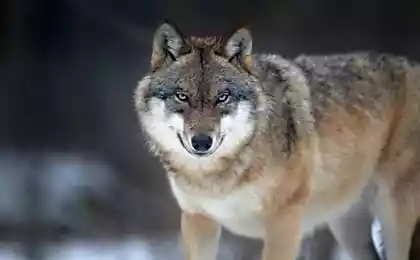655
About wolves, the fragility of ecosytem and ecology of fear
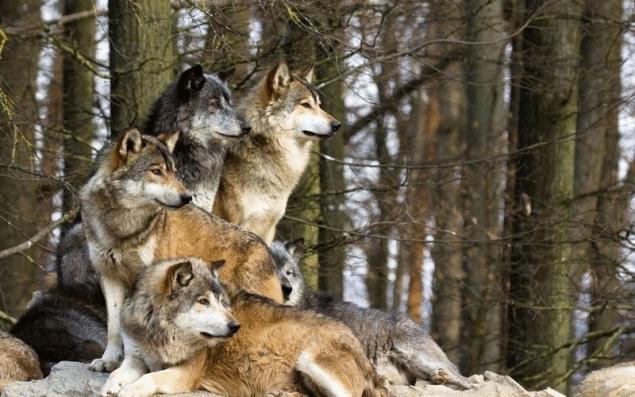
"Windy day in August Professor of botany in the University of Oregon, William RIPL fascinated considering the four-meter poplar growing in the Lamar valley of Yellowstone national Park. "See these renal scars? — asks the scientist trees, bending to the ground a slim trunk and showing me the marks testifying to the rapid growth of the tree. — Moose did not eat it either this year or in the past — they had not touched the tree since 1998!". And if in the Yellowstone Park there were no wolves, poplar would have disappeared completely. Here is clear evidence of the fragility of the ecosystem and convincing evidence of the long-known truth that any intervention in the life of nature can turn the most unexpected surprises.
In 1995, by decision of the national Park Service and the fish and wildlife Service agriculture, in Jelloustonsky national Park was reintroducing three dozen wolves. Over time, predators halve the population of Yellowstone elk, which led to the resumption of growth of many plants. With the emergence of young trees in the Park, returned the beavers. Constructed their dams cause flooding that also accelerates the recovery of vegetation. The return of wolves has affected the life of other inhabitants of the Park-coyotes, Grizzlies, red foxes, ravens, and even small birds.
In the midst of winter 1995, the staff of the national Park Service and the Service of fishing and hunting brought from Canada to Yellowstone 31 wolf (Canis lupus). It was the first wolves that have appeared since, as in the beginning of XX century all gray predators here were wiped out by hunters. Environmentalists had hoped that the reintroduction of wolves will help restore Yellowstone to its former biodiversity. For example, it has been suggested that predators will "cull" some of the many populations of Yellowstone elk. With the extermination of wolves their population in the Park increased rapidly. Brought predators fully met the expectations of scientists. Today, the Park "patrol" 16 wolf packs, each consisting of 10 animals and daily kills one moose. The result is the number of moose that reached to the beginning of the 1990s, 20 000 individuals today is less than 10 000 animals.
RIPL wants in the Park had more trees. "I love poplar" — dreamily says the Professor, sitting over a Cup of coffee in a cozy restaurant not far from Yellowstone Park, where he conducts field research. When, in 1997, to the scholar heard a rumor that the trees in Yellowstone is getting smaller and nobody knows why this is happening, RIPL went to the Park with the intention to unravel the mystery.
Professor studied a sample of 98 poplar wood and found that only two of them sprouted in the late 1920s — at this time in the Park was destroyed last population of wolves. It is curious that both trees grew in a place where out of fear of the grey predators did not dare to go and see the moose. In addition, Reply caught my eye that in Yellowstone or grow very large, or very tiny poplar — trees of medium size were completely absent, as in the period between 1930 and 1990, the elk were not given the opportunity to sprout new shoots. So the scientist has discovered the first clear evidence of the "ecological effects of wolves."
According to this theory, grey predators support a number of elk in the Park, in which those simply not in a position to destroy the new shoots of poplars and willows. When the wolves in Yellowstone were killed and the number of elks has increased rapidly and they literally began to ravage the valley of the river Lamar, gradually displacing her many animal species. For example, with the disappearance of the young trees have lost their main feed beavers, last seen in the Lamar valley in the 1950s And when the rodents stopped building dams and artificial ponds have dried up in the valley became smaller plants-succulent plants — the main food of grizzly bears.
The wolves brought into Yellowstone Park in 1995, began to multiply rapidly. Scientists soon noted not only a decrease in the number of moose, but some changes in their behavior. Huge and powerful ungulates began to spend less time in the rivers, and on land of steel to stick to places where it was easy to observe the approach of the gray predators. If the hypothesis of the "wolf effect" is correct, in Yellowstone Park for the first time in seven decades should turn green young trees.
And they really began to return to the Park. Most of them grew up there, where moose during feeding did not have full 360-degree view of the area. Young-willow, for example, rose at the foot of a low hill that should block shochatim of the area. When you look at these trees once it becomes clear that the teeth of moose not touched their branches for several years. "The animals here don't feel safe, says RIPL. Hence they are unable to see what is happening behind the dunes, and therefore to remain in this place they are afraid." But some 50 m from the hill, where the plain stretches before my eyes and opens a vast panorama of willow barely reach a height of 1 m in three years is clearly not a time to osypalis the moose. "That's what I call the ecology of fear," says the Professor.
Recovery of vegetation in the river valley, Lamar is accompanied by other environmental changes. Just upstream of rose beaver dam is one of the first built by rodents on this river over the last 50 years. On the river Slav Creek (a tributary of R. Lamar) beavers have constructed six such facilities. According to drives ripple, the animals returned to the Park, because now they can feed themselves. Coming and other changes. The younger trees will strengthen the Bank and stop erosion. Under the canopy of dense greenery, the river will become more shady and cool. Into the water to get more crop residue, the accumulation of which will slow down over the pond and make it a more suitable habitat for trout and other large fish.
The impact of wolves, it seems, is not restricted to plant components of the food chain Yellowstone Park. Their appearance, for example, has been greatly affected by the local coyotes. Three years prior to the introduction of predators, the study population of coyotes were doing a senior fellow at the Yellowstone ecological research center Robert Crabtree. After the arrival of wolves, the number of coyotes in the Park decreased by 50%, and in the territory of the wolf packs — 90%. Males coyotes during this time has noticeably decreased in size. Crabtree explains that they were set up against the wolves more aggressive, threatened them, but in the end were defeated. The decrease in the number of coyotes has led to a sharp increase in the number of their victims-voles, mice and other rodents. This, in turn, caused an increase in the number of red foxes and birds of prey. And since, and those and others feed on small birds, their numbers in the Park might also change.
The return of wolves has affected the life of other large carnivorous inhabitants of the Park. Grizzly bears and Cougars attack adult moose is extremely rare. Wolves, by contrast, prefer to attack them. After eating their fill, they usually go to sleep, giving the rest of its production at the disposal of all kinds of animals-PANalytical — from Grizzlies to forty. In Yellowstone, it was registered a record number of ravens (153 birds!), feeding on the carcass of a dead elk. "Every time the remains of a wolf meal eats other animals. We watched as they fed bald eagles, coyotes, ravens and magpies — the head of the project on the reintroduction of wolves Douglas Smith. — I'd like to know what to eat these animals, when no Park wolves".
But does the grey predators became the "driving force" of all the changes? Most scientists answer the question in the affirmative. According to Smith, the wolves of Yellowstone — like water for wetland Park, i.e. the main factor responsible for the formation of an ecosystem. Similar changes biologists have observed in the canadian Banff National Park, when he in the 1980s returned the wolves: a few years after their appearance again here grew willows and doubled the species diversity and abundance of songbirds. Today, scientists are specially come to Yellowstone to explore the first evidence of the powerful influence of gray predators on the ecosystem of the river banks.
Scientific discussion about the impact of wolves on the ecosystem of Yellowstone Park with renewed force the question of the most adequate ways of regulation of number of local elks. There was a time when the national Park Service believed that elk in Yellowstone were simply too many: in the 1960s, there has repeatedly sent groups of Rangers to trap and shoot the animals. By the end of the decade the total number of moose has declined to 4,000 individuals. Under public pressure, their destruction stopped, and in the 1970s the national Park Service began enforcing a policy of "natural regulation" of animal numbers in national parks and decided to turn them into "Islands of virgin America." Since then, the number of elk in Yellowstone began to grow.
Today, after several decades, the state of Montana and other opponents of this approach accuse the national Park Service that a huge herd of elk cause irreparable harm to a vast array of natural pastures. According to them, insane was the idea that nature can evolve naturally in an unnatural situation.
Other researchers argue that all the assurances of the management of the parks Service that the Yellowstone elk population is within natural boundaries, denies the fact of the resumption of vegetation along the banks of Lamar. Smith offers a look at the situation from a different angle. "Over time, says the scientist, — the number of the elks will undergo significant fluctuations. Today they are really too much, however, if we consider population dynamics over a long period, its dimensions do not go beyond natural boundaries".
Whatever it is regarding the "ecological effects of wolves" came the scientists, everything that happens in Yellowstone Park clearly demonstrates that the representatives of the canine inevitably act as a skilled conservators of the natural environment. Elk hunting, they cause huge changes in the ecosystem of the Park. From the point of view of a person many of these changes are very useful — in any case, if they decided to carry out the people, the work would have cost the state a huge amount of money.
Yellowstone wolves taught, and other useful lessons. They clearly showed the important role of predators in higher levels of food chains in maintaining ecological balance and no natural resources lost that part of the country where these predators have been exterminated. Indeed the wolf has become the symbol of all unexpected and unknown consequences caused by ill-considered human intervention in the life of nature."
In the world of science. 2004. No. 9.
Further, it was also shown that "the local wolves, grizzly bears get more edible berries, such as, for example, the fruit of Saskatoon berries (Amelanchier alnifolia). In the work of William J. Ripple et al (2014) compared the percentage of berries in the droppings of bears, collected in 2007-2009 (778 samples) with the data of similar studies carried out 19 years earlier. It was found that in our days the bears eat more berries. In July the remnants of the berries contained in 5.9% of samples (last -0.3%), and in August — at 14.6% (previously 7.8 percent).
The researchers suggested that the factor causing this change was the return to the Yellowstone Park wolves. Bears and moose are competing for berries and bears are in this fight to lose, elk eat most of the fruit. When the national Park was reintroduction wolves, they reduced the moose, so the redistribution of resources in favour of the bears.
The complete elimination of wolves in much of North America in the 1920s led to uncontrolled growth of the elk population. In Yellowstone wolves re-appeared in 1995. Recovering their numbers and in other forests of North America that causes a return of the number of coyotes, elk and deer to the previous level".
Source: www.priroda.su/

